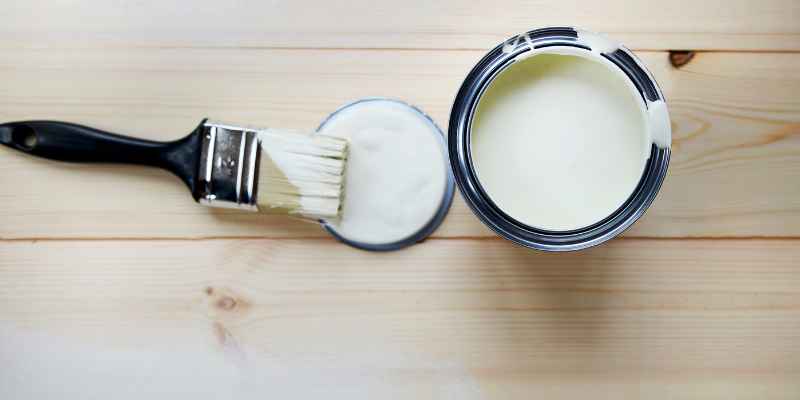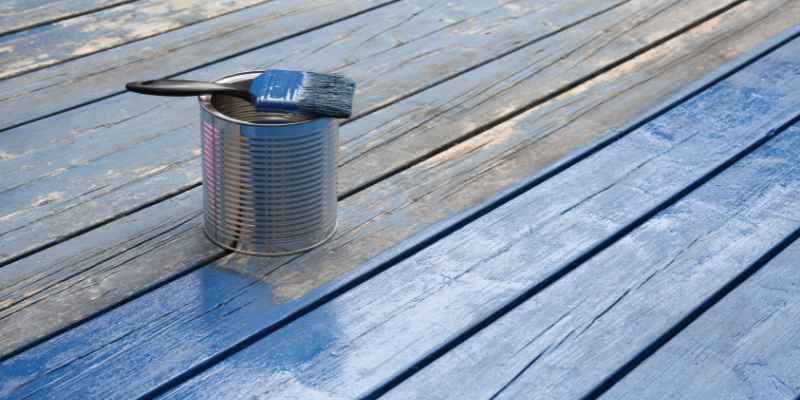Yes, you can paint over painted wood. In fact, painting over previously painted wood surfaces is a common practice to refresh or change the look of furniture, cabinets, or other wooden items.
Preparation For Painting Over Painted Wood
Before you can start painting over painted wood, it is essential to properly prepare the surface. Taking the time to prepare the wood will ensure better adhesion, improve the overall quality of the paint job, and help the fresh coat of paint last longer. The preparation process typically involves three key steps: cleaning the surface, sanding the wood, and priming the wood.
Cleaning The Surface
To achieve the best results when painting over painted wood, it is crucial to clean the surface thoroughly. This step removes dust, dirt, grease, or any other residue that may be on the wood, which can prevent the new paint from adhering properly. Here’s how you can clean the surface:
- Start by wiping the wood with a damp cloth or sponge to remove loose dirt and debris.
- If there are any stubborn stains or grease spots, use a mild detergent mixed with water to gently scrub the area.
- Rinse the wood with clean water and allow it to dry completely before moving on to the next step.
Sanding The Wood
Sanding the wood is essential for achieving a smooth and even surface for the fresh coat of paint. Sanding not only helps to remove any old, peeling paint or imperfections but also improves paint adhesion. Here’s how you can sand the wood:
- Start by selecting the appropriate grit sandpaper. Generally, a medium to fine-grit sandpaper, around 120 to 220 grit, works well for most painted wood surfaces.
- Using light pressure, sand the entire surface in the direction of the wood grain. This helps to avoid creating scratches or uneven spots.
- Pay extra attention to any rough areas, drips, or peeling paint, and sand them until smooth.
- Once you have sanded the entire surface, wipe away the dust with a clean cloth.
Priming The Wood
Priming the wood is a crucial step in the preparation process, especially if you are planning to paint over a dark or glossy surface. Primers create a smooth and even base, allowing the paint to adhere better and provide a more durable finish. Here’s how you can prime the wood:
- Choose a suitable primer based on the type of paint you will be using and the condition of the wood.
- Apply the primer evenly using a brush or roller, following the manufacturer’s instructions for drying times.
- Allow the primer to dry completely before applying the paint. This ensures proper adhesion and prevents the paint from peeling or chipping.

Techniques For Painting Over Painted Wood
When it comes to painting over painted wood, there are several techniques you can use to achieve a smooth and professional finish. Whether you prefer using a brush, spray painting, or a roller, each method has its own advantages and considerations. Read on to find out more about these techniques and how to make the most out of them.
Using A Brush
Using a brush to paint over painted wood is a traditional and reliable method. It allows for greater control and precision in covering the surface evenly. To achieve the best results, follow these steps:
- Start by cleaning the painted wood surface thoroughly to remove any dirt or grease buildup.
- Lightly sand the surface to provide a better adhesion for the new paint.
- Apply a primer coat to ensure the paint adheres well and provides a smooth finish.
- Once the primer is dry, apply the paint using smooth brush strokes, following the natural grain of the wood.
- Apply multiple thin coats rather than one thick coat to prevent drips and achieve even coverage.
- Allow each coat to dry completely before applying the next one.
- For a smoother finish, lightly sand the surface between coats.
Spray Painting
Spray painting can be a quicker and more efficient method, especially when dealing with larger surfaces. Here’s how to get the best results when spray painting over painted wood:
- Prepare the surface by cleaning it thoroughly and sanding any rough areas.
- Protect surrounding areas from overspray by covering them with drop cloths or plastic sheets.
- Choose the appropriate type of spray paint for your project, whether it’s oil-based or water-based.
- Hold the spray can or paint gun at a consistent distance from the surface to ensure an even application.
- Apply multiple thin coats, allowing each coat to dry before adding another layer.
- Remember to work in a well-ventilated area and wear appropriate safety gear to protect yourself.
Roller Painting
Roller painting is another popular technique for painting over painted wood. It can be especially useful for covering larger areas quickly. To achieve the best results, follow these steps:
- Clean the painted wood surface thoroughly to remove any dirt or grime.
- Sand the surface lightly to create a smooth and even texture.
- Choose a roller cover suitable for the type of paint you’re using and the desired finish.
- Apply a primer coat to ensure good adhesion and a professional-looking finish.
- Once the primer is dry, pour the paint into a tray and roll the roller cover in the paint to evenly coat it.
- Start painting by rolling the roller cover onto the surface using smooth and even strokes.
- Work in small sections and overlap each stroke slightly to ensure full coverage.
- Allow each coat to dry completely before applying additional coats.
- Clean the roller cover thoroughly after each use to maintain its quality.
Tips For Achieving A Smooth Finish
Looking to achieve a smooth finish when painting over painted wood? Here are some helpful tips to ensure a seamless and professional-looking result.
Choosing The Right Paint
When it comes to achieving a smooth finish when painting over painted wood, choosing the right paint is crucial. Opting for a high-quality paint that is specifically formulated for wood surfaces can make all the difference in the final result. Look for paint products that are labeled as “wood paint” or “wood primer,” as they are designed to adhere well to the surface and resist cracking or chipping over time.
Applying Thin Coats
To avoid a bumpy or uneven appearance, it’s essential to apply thin coats of paint when working with painted wood. Thick layers of paint can take longer to dry and may result in a less smooth finish. Instead, use a brush or roller to apply a thin coat of paint and allow it to dry completely before applying subsequent layers. This will help you achieve a smooth and professional-looking finish.
Allowing Proper Drying Time
Another important tip for achieving a smooth finish when painting over painted wood is to allow each coat of paint to dry properly before proceeding. Rushing the drying process can lead to smudges, streaks, or damage to the paint surface. Ensure that you follow the manufacturer’s instructions for the specific paint product you are using, as drying times can vary. Patience is key here, as allowing each coat to dry fully will result in a flawless finish in the end.

Common Mistakes To Avoid
When it comes to painting over painted wood, there are a few common mistakes that you must avoid to ensure a smooth and long-lasting finish. By understanding these mistakes and taking the necessary precautions, you can achieve professional-looking results without any hassle. In this article, we will discuss three of the most common mistakes to watch out for when painting over painted wood.
Not Preparing The Surface Properly
Proper surface preparation is essential for any painting project, and when it comes to painting over painted wood, it becomes even more crucial.
Many homeowners make the mistake of not properly preparing the surface, resulting in paint flaking, peeling, or not adhering well. To avoid this, follow these steps to prepare the painted wood surface:
- Start by cleaning the surface thoroughly using a mild detergent or Krud Kutter. This will remove any dirt, grease, or grime.
- Sand the surface gently with fine-grit sandpaper to create a rough texture that helps the new paint bond better.
- Fill any cracks, dents, or holes with wood filler and sand it smooth once it’s dried.
- Finally, wipe the surface with a clean cloth to remove any dust or debris before you start painting.
Using The Wrong Type Of Paint
Using the wrong type of paint is another common mistake that people make when painting over painted wood. It’s important to choose the right paint to ensure a durable and long-lasting finish.
When selecting paint for painting over painted wood, consider the type of wood, the current paint finish, and the desired result. Latex paint is a popular choice for previously painted wood surfaces, as it provides excellent coverage and is easy to clean up. However, if the wood is exposed to moisture or high traffic areas, an oil-based paint may be a better option for better durability.
Applying Too Thick Coats
It’s important to apply paint in thin and even coats when painting over painted wood. Applying thick coats can lead to drips, uneven drying, and difficulty in achieving a smooth finish. To ensure proper application:
- Use a high-quality brush or roller suitable for the type of paint you are using.
- Apply thin coats of paint, allowing each coat to dry completely before applying the next.
- If necessary, apply a primer coat before applying the final paint coat to achieve better adhesion and coverage.
- Follow the manufacturer’s instructions regarding the drying time between coats.
By avoiding these common mistakes, you can save time, effort, and money while achieving a beautiful and long-lasting paint finish on your painted wood surfaces.
Conclusion
Painting over painted wood is indeed possible with the right preparation and techniques. By following the necessary steps, such as cleaning and sanding the surface, applying a primer, and using the appropriate type of paint, you can achieve a fresh and updated look for your wooden surfaces.
Remember to choose high-quality products and take your time to ensure a smooth, long-lasting finish. Happy painting!


